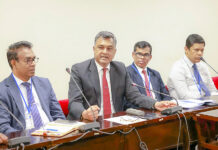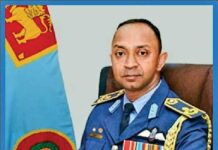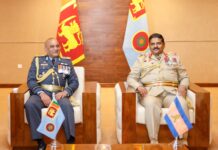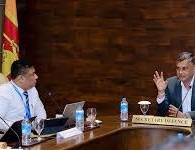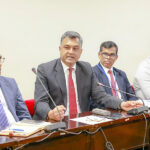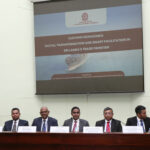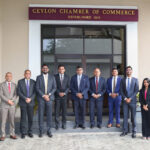Compiled by : Gp Capt Kumar Kirinde [retd], SLAF
How it began: Establishing and operating an airfield by the RAF in Negombo (Katunayake) during the period 1942 to 1957
The first squadron of aeroplanes that the RAF brought to Ceylon were Hawk or Hurricane fighters. They were based in the new airfield in Ratmalana. It as the initial stages of the Second World War…A temporary air filed was also constructed by the RAF at Colombo Racecourse Grounds. The 258 Squadron of Hurricanes operated from this airfield right in the middle of Colombo 7. The next airfield opened by the RAF was in Negombo. The location was a large coconut plantation bordering the Negombo lagoon…
Source: ‘A Centenary Sky – 100 years of Aviation in Sri Lanka’ by Capt Elmo Jayawardena
The Ratmalana airfield was getting busy. This was 1939…The military movements in and out of Ceylon had increased by mega numbers. That kept Ratmalana ticking at a pace it wasn’t used to. The RAF squadrons stationed there added a huge quantum to the number of aircraft taking off and landing…An alternate airport became a pressing need…Negombo was the answer they found. The Colonial Government authorised the RAF to build an airfield in Negombo in the hamlet of Katunayake. About 40,000 coconut trees were felled and the land cleared, and the new Negombo airfield took shape with a single runway and ample room for expansion…
Source: ‘A Centenary Sky – 100 years of Aviation in Sri Lanka’ by Capt Elmo Jayawardena
Negombo airfield was built by the British in the mid 1940’s to replace their lost airfields in Pakistan and India. Kat was conveniently situated twixt Aden and Singapore to serve the continuing need of supplying its vast Empire particularly so in the Far East and was used as a staging post to rest crews and passengers of aircraft in transit. The airfield was built among a plantation of 40,000 coconut trees and lies some 20 plus miles north of the capital city Colombo and less than a handful of miles east of Negombo…
Source: http://rafkatunayake.tripod.com/


RAF Negombo was developed as a major Staging Post for aircraft in transit to and from the Far East in 1945. Situated in a plantation of coconut trees Negombo was selected as the proposed airfield being positioned 19 miles north of the Ceylon (Sri Lanka) capital Colombo and just a handful of miles East of Negombo with the main Negombo Rail and Road network running immediately to the West of the RAF Station. Although built as a single runway a further runway was planned in 1945 running parallel to the East-West runway along what was the 9-hole golf course but was never added…
Source: http://splashdown2.tripod.com/id20.html



Air operations at RAF Station Negombo
Thousands of palm trees in one of the best coconut plantations in Ceylon were felled 10 make way for Negombo, on a site some 28 miles north of Colombo, selected for a Very Heavy Bomber station in 1944. Originally known as Katunayake, it was renamed Negombo in March 1944. However, it was never to parent its own heavy bomber squadrons, and instead became primarily an important staging post for transport aircraft flying to and from the Far East. Halifax VIIIs, attached from 298 Sqn, carried out transport support operations from here between December 1945 and May 1946, at which time 1303 Meteorological Flight was also on strength. During March 1946 RAF Liberators from Kankesanturai (another Ceylon base) used the airfield to mount sorties in search of Lancastrian G-AGLX, which had vanished after taking off from Negombo to Australia.



When Negombo’s first resident squadron, No. 45, took up post in April it changed role from light bomber to maritime strike. Initially the Squadron was equipped with Mosquito VIs which were also used for twice-weekly meteorological flights, from which TE640 was lost in November. During the same month Avro Yorks on the UK – Singapore route began scheduled services through Negombo, and this four-engined transport would become a very familiar sight, later building up to a peak of around seven per day.
Mosquitoes were not a success in the Far East, and in December 1946 No 45 Sqn began training on the Bristol Buckmaster prior to converting to Beaufighters. The flow or heavy transport aircraft gradually increased, reaching a figure of over 200 per month in September 1947, this total including Skymasters, and the Constellations of KLM which had also begun using the airfield. Another civilian user was BOAC, which by March 1948 was operating a weekly Lancastrian service between the UK and Singapore. The Station also became home for Air Headquarters (AHQ) Ceylon, which was relocated here early in 1943. The AHQ Communications’ Fight had already been based at Negombo for some time.
The Station assumed something of its originally intended heavy bomber role when five Lincolns from 97 Sqn (Hemswell – UK) were attached in May 1948 for Operation Red Lion 11. Joined by 45 Sqn, the Lincolns mounted two practice bombing operations before leaving for Singapore.
The requirements of the Berlin Airlift resulted in a temporary break in York traffic in July, but there were always other visitors to keep the Station busy: for an example, two USAF B-29 Super fortresses (‘Gas Gobbler’ and ‘Lucky Lady’ of the 43rd Bomb Group) which later left to continue their round-the-world flight
The Malayan Emergency prompted a 45 Sqn detachment to Kuala Lumpur in September 1948, the remainder of the Squadron following permanently in May 1949. During the month No. 45 had received Bristol Brigand Met3s, but these remained behind at Negombo to form 1301 Meteorological Flight, which specialized in weather reconnaissance fights in the South West and North East Monsoon areas.
The RAF Transport Command schedules which were resumed in July 1949 were now being flown by Hastings alongside the older Yorks, BOAC was still a regular operator, and October saw the proving flight of the Canadair C-4 in the airline’s livery. Other civilian operators to be seen at the beginning of 1950 included Air India and Air Ceylon, For Ceylon’s Independence Day celebrations on 4 February 1950 the Station put up formations of Dakotas, Brigands and Sunderlands, extra aircraft being ‘borrowed’ from Singapore, By May It was the practice of a Dakota to be attached from one of the Singapore transport squadrons for air/sea rescue duties, and under this long-standing arrangement the ‘Daks’ could also be employed on communications flying, Army cooperation, and jungle rescue operation work as necessary. Ad hoc basis taken on by 1301 Met Flight (which also has its own Harvard), on the other hand, included ship interceptions, though the unit ceased to function towards the end of the year.
The air/sea rescue detachment also began to feature Vickers Valettas by early 1952, and in April, for example, VX355 (from 52 Sqn) took part in the search for a Ceylon Air Academy Auster which had ditched at sea. Negombo’s Staging Aircraft Servicing Flight were presented with plenty of traffic on which to exercise their talents, including four Lancasters of 38 Sqn (Malta) attached for Exercises with the fleet, Transport Command Hastings, the AOC’s York (LV633) and even the Station Flight Harvard (FT186). Due to its location the Station naturally attracted maritime-related visitors, including Dakotas of 35 Sqn, RAAF, for ASR work, and in August 1952 six Shackletons from 224 Sqn (Gibraltar) for various exercises which also drew Beaufighters from Singapore. A sign of the times was the increasing number of training fights by the Royal Ceylon Air Force.
Undoubtedly the most interesting event of 1953 was the England to New Zealand Air Race which produced a crop of unusual visitors, not only in the form of competitors but also preparatory ‘hangers on’. In the months leading up to the race RAF Canberra WE139 and ‘142’ both carried out proving flights, while Boeing Washington brought in teams of RAF engineers surveying the route. On the day of the race itself (9 October) the RNZAF competitor, Hastings NZ5804, landed after three attempts, on three engines during a heavy thunderstorm. The Hastings flaps were badly damaged by runway water, and a spare engine was later flown in aboard Bristol Freighter NZ5901. Other competitors noted that day included Canberra and Viscount G-AMAV.
The location filming of H. E. Bates novel The Purple Plain brought Negombo immortality in January 1954. For this, two 81 Sqn Mosquitoes (RG238 and RE177 – the former replaced later by PT669) were flown in from Singapore, and the Station also provided much other material for this production. The spring months saw many Lincolns, Canberras and Shackletons transiting to the Far East, and by now a Rescue Coordination Centre had been established here.

For some time, HQ FEAF had planned to send six Vampires from Singapore to Ceylon to prove the ability to reinforce the island with interceptor fighters. The visit was finally scheduled to coincide with an air display at neighboring Ratmalana in January 1955, and the Vampires (from 60 Sqn at Tengah) plus shepherding Valetta duly arrived, remaining for ten days.

“Jet 55” was the name given to an exercise with local naval units held in August 1955, for which four Shackletons from 224 Sqn were attached. The pattern was repeated the following year, with 220 Sqn providing the Shackletons, which again flew sorties in the Trincomalee area.
With the taken over of the Station by the Royal Ceylon Air Force in 1957 came a reversion to the name of Katunayake. Up until November Air Headquarters Ceylon functioned alongside a disparate collection of units including Ceylon Air Traffic Control Centre; Signals Centre; Ceylon; No 41 Movement Unit; No 7 Mobile Oxygen Unit; and an RAF Hospital, but even this activity ceased in September 1960.
… will be continued on Monday the 8th November




